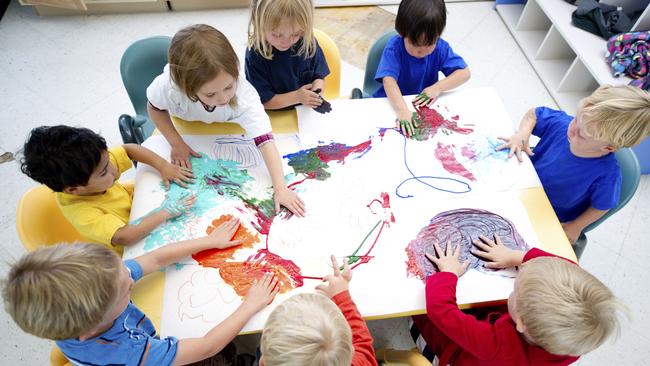NSW Childcare: Southern Highlands classified as ‘childcare desert’ as child care waitlists hit triple digits
Childcare professionals warn the lack of childcare availability in the Southern Highlands will have a negative impact on development as parents, including a local GP, encounter triple digit waitlists at centres as they struggle to return to work.

NSW
Don't miss out on the headlines from NSW. Followed categories will be added to My News.
Childcare professionals warn the ‘childcare desert’ in the Southern Highlands will have a negative impact on development as parents encounter triple digit waitlists at centres as they struggle to return to work.
A report from Victoria University affiliated Mitchell Institute revealed that some three million people in NSW are living in ‘childcare deserts’, which are areas where there are more than three children for every childcare place available.
The situation is dire in the Southern Highlands, where there are 3.28 children for every space at a local childcare centre. The report shows nearly half of the Wingecarribee Shire is classified as a ‘childcare desert’, in comparison to the 35 per cent of the area in neighbouring Goulburn.

Closer to Sydney, the number of children fighting for a childcare place in Camden drops to just over two and only 16 per cent of the area is affected.
The geographical divide is stark, with suburbs in the inner city enjoying a range of childcare options, while regional NSW residents have to compete for very few places and travel further to do so.
It’s a problem Dr Rosie Hanbury knows well. The new mother has recently returned to work four days a week at Mittagong Medical Centre, but she is worried she may have to cut down on work if she’s unable to access childcare.
“As a local GP, patients can’t get to see me (during the shorter week) and I want to be available for them, but I can’t get anyone to look after my baby,” she said.
Dr Hanbury put her son’s name on the waitlist for a number of preschools nearly ten months ago, but he is yet to be placed.

“Anecdotally, it’s an issue for everyone I’ve spoken to,” she said.
“There’s just no availability.”
Dr Hanbury said she and her husband rely on help from her mother, who lives locally, to look after their baby.
“We’re so lucky we have my mum. I wouldn’t be able to return to work without her,” she said.
If it wasn’t for the help of her family, Dr Hanbury said she would have to cut down her working hours to two days a week.
Luckily her husband has been able to secure paternity leave for four months, which will tide the family over until the situation becomes desperate.
“After that, we’re going to be stuck,” Dr Hanbury said.
The family found even childcare alternatives like nannies are very difficult to secure and are still looking for help. Dr Hanbury said the lack of childcare in the Southern Highlands was very concerning.

“It’s crazy that they’re not able to offer any certainty, which isn’t their fault, but it’s a flawed system,” she said.
“If you have a child, you basically have to put their name down the second you find out you’re pregnant.”
The lead author of the research report, Dr Peter Hurley, said that may be too long.
“People are talking about getting their child on waiting lists before they even get pregnant,” he said.
The report notes that women living in childcare deserts, like Dr Hanbury, were less likely to be in the workforce while they had children under five.
Hannah Matthews, a policy fellow at the Mitchell Institute, explains that it’s not simple to differentiate between which factor comes first: availability, or demand.
“Lower levels of workforce participation will affect levels of childcare, but it could work the other way, leading them to choose to not participate in the workforce or as much as they’d like while their children are young,” Ms Matthews said.

Director of Mittagong Preschool Kindergarten, Pauline Iacono, said the lack of childcare in the Highlands has been “a major problem” for the last nine years.
“Prior to that, we were always having children for two years before they went to school, but we got to the point where we’re only having children for one year,” she said.
“There’s still children who are missing out on any attendance at preschool and then they go off to school next year. So there’s definitely a problem.”
The childcare professional warned the lack of services would have a negative effect on children’s development, leaving many unprepared for the challenges of school.
“It obviously has a big impact (on children),” she said.
“For some children, one year of preschool education before they enter formal schooling is good preparation but, for other children, if they’re maybe more introverted or they need more support to develop their skills, the one year is just not enough for them.”

Ms Iacono said missing out on prior-to-school learning would lead to children who are ill-equipped emotionally and socially to handle school.
Traits like independence, resilience and social interactions are “very much confidence-based” and children need to build that confidence with exposure, the preschool director said.
Although the numbers are skewed because the preschool allows registration from birth, Ms Iacono said the eye-watering waitlist for Mittagong Preschool Kindergarten is between 250 and 300 children long.
The preschool is only able to accommodate 80 children a year, with around 25 of those returning the following year.
“It’s very stressful placing (children), because you hear everybody’s needs but you just know from the beginning that you can’t make a place for everyone,” Ms Iacono said.
Older children get priority because of the funding model for the centre, which is a unique not-for-profit preschool run by parents volunteering their time and focusing on a holistic approach to childcare in a community setting.

Although Mittagong Preschool Kindergarten doesn’t cater to children younger than two, Ms Iacono said the shocking lack of childcare is even more pronounced in that age group.
“I have been hearing it’s almost impossible to find anything for twos and unders,” she said.
“There’s just no places available.”
According to Dr Hurley, there needs to be structural change in the childcare sector to facilitate universal access of at least three days a week for every child each week.
More Coverage
Originally published as NSW Childcare: Southern Highlands classified as ‘childcare desert’ as child care waitlists hit triple digits




